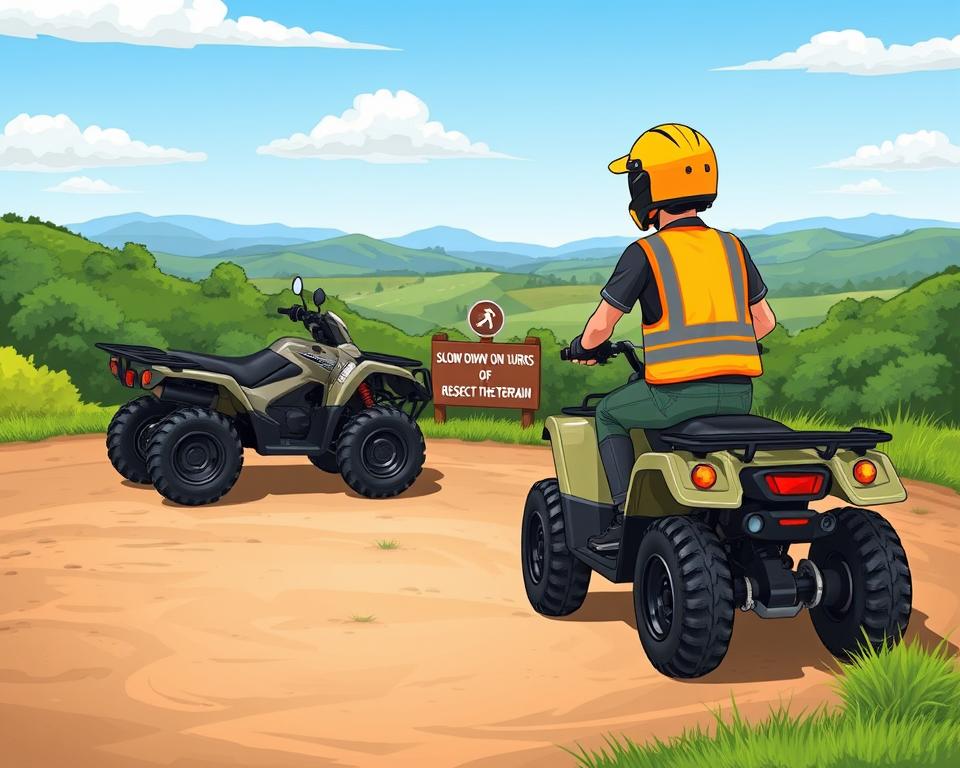How New Riders Can Avoid ATV/UTV Gear Selection Pitfalls
Were you aware that nearly 35% of new ATV and UTV owners face gear selection issues within their first year? Such data emphasizes how critical gear ratios are for novice riders. Correct gear choice protects against accidents as well as enhances power. In this guide, we cover typical errors, upkeep tips, and pro Polaris ranger 500 roof recommendations for better trail experiences.
Major Highlights

- Mastering gear ratios unlocks top performance.
- Neglecting gearing details increases accident hazards.
- Regular maintenance is key to preventing UTV transmission issues.
- Proper gear selection greatly enhances off-road riding experiences.
- Implementing ATV maintenance tips can prolong vehicle lifespan.
Understanding ATV and UTV Gear Ratios
Ratios determine how engine output translates to drive force. They govern both top speed and hauling capacity. This controls how quickly you get up to speed and tow trailers. Different gear ratios can transform a vehicle’s performance, making it better suited for racing, off-road driving, or towing.
Picking the correct ratio optimizes power delivery. A low gear ratio can hinder torque during steep climbs or when carrying heavy loads. On the other hand, a high gear ratio can slow down acceleration, making it tough to speed up on straight paths.
Adjusting reduction influences handling in mud, sand, and rock. Ratio mods shape how your rig behaves off-road. This ensures the machine operates efficiently, whether prioritizing speed or torque. Achieving the right balance in ATV gear ratios improves the driving experience and boosts efficiency.
Common Gearing Oversights for New ATV/UTV Owners
Correct gearing secures top output and trail safety. Rookies often miss key selection factors. Grasping misgear consequences and correct choices elevates your performance. Plus, it prevents mechanical setbacks.
Impact of Incorrect Gear Selection
Choosing the wrong gear can lead to serious problems, including loss of control and mechanical failures. The wrong gear can slow down acceleration, affect braking, and cause excessive wear. These mistakes can significantly reduce riding safety, posing risks to the rider, passengers, and others nearby. Using maintenance best practices wards off these hazards.
Choosing the Right Gear for Terrain
Each surface demands its own ratio. Climbing requires low-end grunt from smaller ratios. On flat terrains, higher gears help increase speed. Soft ground demands careful gear choice for grip. Knowing these environmental factors is critical for safe and enjoyable off-road adventures.
The Importance of Proper ATV Maintenance
Scheduled service avoids surprises on the trail. Using upkeep best practices stops breakdowns and protects riders. A smart maintenance regimen targets gearbox longevity.
Regular Inspection and Maintenance
A detailed inspection checklist is essential for spotting issues early. It’s important to check gears, brakes, tires, and belts regularly. Routine checks lead to peak performance. Here are some critical inspection points to remember:
- Inspect gearbox alignment and pitting.
- Ensure all fasteners are tight.
- Check master cylinder and calipers for leaks.
- Measure wheel pressure and wear.
- Inspect battery terminals and cables for buildup.
Fluid Changes and Gear Health
Fluid quality is critical for UTV drivetrain maintenance. Frequent changes clear out contaminants. Pure coolant and oil lower temperatures and prolong service intervals. By following these practices, you can maintain your gear in top condition, ensuring reliable performance on every ride.
| Fluid Type | Recommended Change Interval | Benefits of Regular Change |
|---|---|---|
| Engine Oil | 50–100 operating hours | Cuts friction and boosts power |
| Gear Oil | 100–200 operating hours | Improves shifting, minimizes gear damage |
| Coolant | Once per year | Stops boil-overs and freezes |
Adhering to this schedule grants worry-free adventures. It turns rides into stress-free experiences.
Common ATV Gear Shifting Problems
New ATV riders often face challenges with gear shifting. Developing fluid shift skills elevates trail enjoyment. This stops shift-related aggravation. Synchronizing engine speed and clutch engagement stops misshifts.
Learning to Shift Smoothly
Developing smooth shifting techniques requires a few practices. First, feel your engine’s rev pattern. Smooth gear engagement reduces transmission stress and prevents issues. Blending throttle with clutch release ensures seamless shifts.
Drill shifts in an open space to build skill. Keep your throttle light when shifting.
Recognizing Signs of Gear Issues
Spotting problems early prevents breakdowns. Watch for whines, clanks, or crunches in the gearbox. Hard shifts or missed gears indicate trouble. Addressing issues promptly protects components and riders. Resolving shift issues preserves power delivery and morale.
Understanding UTV Transmission Issues
Dealing with UTV transmission problems can be tough, but knowing the common issues is vital for troubleshooting. Owners often face issues like slipping gears or odd noises. This section delves into these frequent problems and offers a detailed approach to diagnose and fix them. Leveraging user-friendly diagnostic procedures.
Diagnosing Common Problems
Identifying symptoms early prevents bigger issues. Common issues include:
- Unexpected gear drops that compromise handling.
- Weird whines or crunches hinting at worn parts.
- Drips or puddles under the UTV may foretell failures.
Regular gear diagnostics help spot these issues quickly. This allows for prompt action. Missing early clues damages your ride and wallet.
Solutions for Troubleshooting UTV Transmissions
Fixing UTV transmission issues requires a systematic approach. Follow these steps for effective troubleshooting:
- Ensure gearbox fluid is at spec, then add if low.
- Look for wet spots beneath the transmission.
- Open housing to check bearings and gears.
- Test drive the UTV at various speeds to monitor gear engagement and responsiveness.
- Consult the owner’s manual for specific diagnostics related to your model.
Leveraging a proven guide speeds up repairs. Understanding gear mechanics is key for any UTV owner. That insight preserves reliability and output.
ATV Clutch Adjustments and Their Benefits
Right clutch settings smooth out gear changes. Bad clutch setup leads to gear grind and confusion. Regular adjustments improve clutch performance, leading to better gear shifting.
Precision in gear changes is critical. A well-set clutch delivers fast, clean shifts. It refines acceleration and comfort across all conditions.
Skipping clutch care leads to early failures and poor shifts. Proper maintenance leads to smoother shifts and better engine response. Every operator should prioritize clutch checks for optimal use.
Mastering the Art of Gear Shifting
Excelling at transitions elevates your trail adventures. Understanding drivetrain function and shift timing is crucial. Beginners should focus on the rhythm of shifting gears. A comfortable cadence leads to smoother transitions and improved performance.
Proficient gear shifting demands practice, across various riding conditions. Knowing shift points for hills, flats, and mud secures handling. Downshifting into grades safeguards momentum and balance.
- Drill slow shifts to master the clutch.
- Listen and feel each gear engagement.
- Step up to steeper, rougher trails as you improve.
Developing a feel for your machine is essential in mastering gear control. Heed revs and shakes to know shift points. This helps determine the optimal moments to shift. That instinctive skill yields seamless shifts and more fun.
Best Practices for UTV Gear Selector Problems
Managing UTV gear selector problems demands a proactive maintenance and diagnostic approach. Routine linkage reviews catch wear promptly. Perfecting selector methods wards off glitches. Inspect link rods and fluid status as part of every service.
If you suspect a fault, inspect the lever assembly for bends or breaks. Squeaks might indicate misalignment. Minor tweaks typically fix selector snags. Scheduled servicing prevents selector degradation.
Tracking shift quality across terrains isolates faults. Following these methods preserves selector health and rider trust.
Tips for Enhancing Gear Performance
Sustaining peak gear health involves systematic care. Routine service boosts ATV efficiency. Verify oil levels, examine parts, and tweak calibrations. Catching nicks before they worsen saves you big bucks.
Selecting proper reductions yields prompt acceleration and fluid movement. Understanding the terrain you will face allows you to select the appropriate ratios. It shapes your bike’s quickness and runway performance. Seeking parts from specialists such as American Off-Roads aids in UTV performance enhancements.
Implementing gear performance tips in wheels, springs, and ballast optimization elevates function. Making these adjustments ensures that both ATVs and UTVs handle better in challenging environments. Your rides become more fun and less fatiguing. Implementing these strategies will allow riders to navigate with confidence while enjoying the thrill of the ride.
Wrapping It Up
Nailing gear selection unlocks peak power and protection. Selecting proper ratios for each trail elevates your experience. Steering clear of rookie errors and picking wisely ensures safe, thrilling rides.
The importance of performance maintenance cannot be overstated. Scheduled maintenance and TLC save you from breakdowns and prolong service. Adequate maintenance enhances function and safeguards adventures across any terrain.
Understanding gear selection and prioritizing maintenance leads to a more fulfilling experience for ATV/UTV fans. Adopting these practices ensures many memorable rides and adventures in the future.
FAQ
Standard gear ratios on off-road rigs?
Gear ratios span a broad spectrum across makes and models. Most fall between about 3:1 and 5:1. Low-end ratios yield higher pulling power. Higher ratios, on the other hand, can increase top speed on flat terrain.
How can I determine if I’m using the wrong gear for my terrain?
Using the wrong gear can lead to loss of control, excessive engine revving, or poor acceleration. Each terrain type—mud, sand, rock, or snow—requires specific gear selection for optimal performance.
Warning signs for upkeep on your off-road vehicle?
Look out for signs like difficulty shifting gears, unusual noises from the transmission, fluid leaks, or a decrease in performance. Periodic drive train reviews ward off costly repairs.
When to swap your drivetrain oils?
Aim for a fluid swap between 1,500–2,500 miles or annually, whichever comes first. Pure oils maintain smooth shifts and protect internals over time.
What techniques should I use for smooth gear shifting?
For smooth gear shifting, practice coordinating the throttle and clutch. Feather the clutch up while winding the throttle for a perfect match.
How can I troubleshoot UTV transmission issues?
First, inspect oil, then note any unusual gearbox sounds. Inspect the transmission fluid level and condition. Then, perform a basic diagnostic to identify any mechanical failures.
Why adjust your ATV clutch?
Well-set clutches ensure crisp gear changes. Incorrect clutch setup strains the gearbox and causes sticky shifts.
Adapt gearing for every surface?
Try different ratio setups and check out trusted upgrades from American Off-Roads. Regular maintenance, such as checking gear health and fluid levels, also enhances performance.
Addressing a bad gear selector?
Regular inspections and routine maintenance are key. When the shifter binds, use the OEM troubleshooting procedures to find the root cause.
Beginner pitfalls in gear selection?
New owners often overlook the importance of understanding gear ratios, neglect routine maintenance, or fail to adjust gears according to terrain. These mistakes hamper performance and raise the chance of mishaps.

